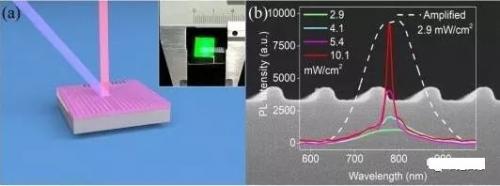Professor Wu Xiang, Professor Lu Ming and Associate Professor Zhang Shuyu from the Department of Light Science and Engineering, Fudan University, successfully developed the world's first all-silicon laser based on the high-gain silicon nanocrystalline film developed. This achievement was recently reported in the form of a bulletin by Science Bulletin. (a) Schematic diagram of optical pumping and illumination of a DFB all-silicon laser; illustration: physical picture of the DFB laser device; (b) PL spectrum of the sample as a function of pump power; background: SEM image of the cross-section of the DFB structure Integrated silicon optoelectronics combines the best of today's two pillar industries—the microelectronics industry and the optoelectronics industry—and is expected to bring new technological revolutions in communications, sensing, lighting, display, imaging, and inspection. Silicon lasers are the key to achieving integrated silicon optoelectronics. Due to the indirect bandgap structure of silicon, the optical gain of silicon is currently 1-2 orders of magnitude smaller than that of the conventional III-V laser materials. In order to avoid this bottleneck, the mature III-V laser is prepared on a silicon substrate and becomes a hybrid silicon-based laser. The all-silicon laser with silicon itself as the gain medium can better match the existing silicon process and greatly improve the reliability of the device. Its development is both a scientific and technical challenge and a necessary integration of silicon photoelectrons. In order to greatly enhance the optical gain of silicon, Professor Wu Xiang, Professor Lu Ming and Associate Professor Zhang Shuyu of Fudan University first learned and developed a high-density silicon nanocrystalline film growth technology, which significantly improved the luminous intensity of the silicon light-emitting layer. Afterwards, in order to overcome the problem that the hydrogen passivation method cannot fully saturate the dangling bond defects, they developed a new high-pressure low-temperature hydrogen passivation method, so that the optical gain of the silicon light-emitting layer can reach the common III-V laser material. On the basis of this, they designed and prepared the corresponding distributed feedback (DFB) resonator, and finally obtained the optically pumped DFB type all-silicon laser. The successful development of optically pumped all-silicon lasers also provides a reference for the next step in the development of electrically-pumped all-silicon lasers. It is found that with the high-pressure low-temperature hydrogen passivation, the optical gain of the silicon light-emitting layer continues to increase, eventually reaching the levels of GaAs and InP. All criteria for meeting the laser generation conditions were also observed in the experiment: threshold effects, sharp narrowing of the lines, polarization effects, and directional emissions. The lasing peak is at a wavelength of 770 nm. They then repeated the preparation of four lasers of the same structure. Since the effective refractive indices of the respective light-emitting layers are slightly different, the obtained four lasing peak wavelengths are distributed in the range of 760-770 nm, and the half-width (FWHM) is reduced from about 120 nm before lasing to 7 nm after lasing. Lip Butter,Natural Lip Balm,Homemade Lip Balm,Fresh Lip Balm Hangzhou Shibode Technology Co., Ltd. , https://www.inblooming88.com
February 28, 2023